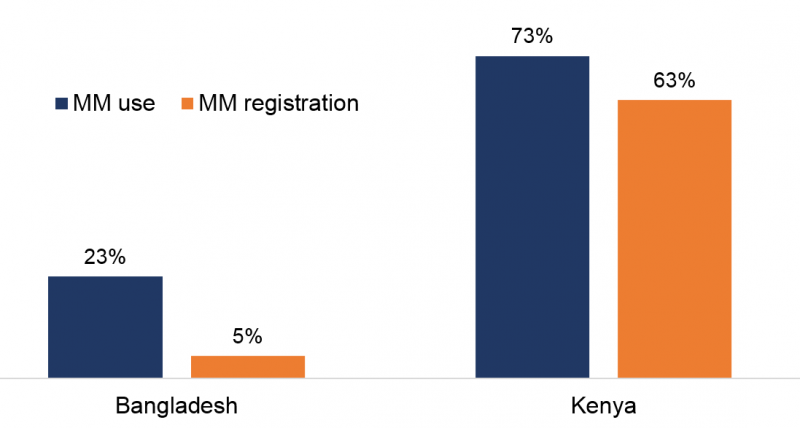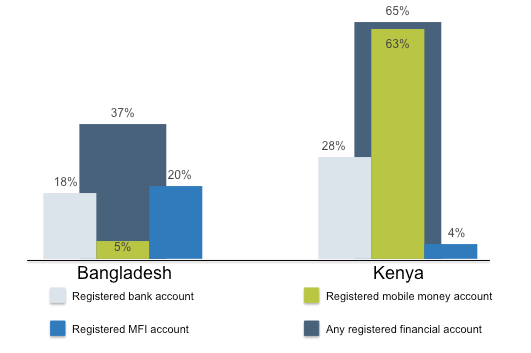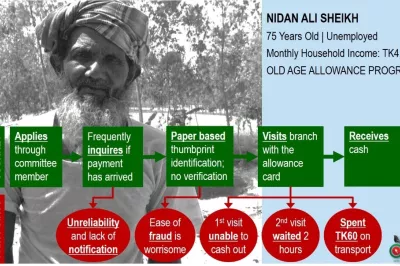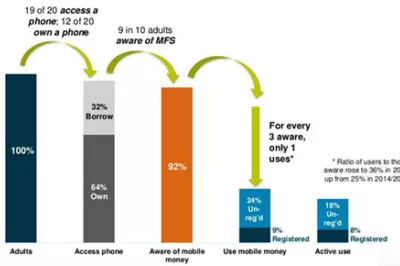Mobile Money in Bangladesh: Still a Long Way to Go
To say that mobile money in Bangladesh is growing fast is an understatement. During 2014, Bangladesh added 12 million new registered accounts, making it one of the fastest growing markets by total accounts in the world. But this absolute figure obscures the fact that 95% of Bangladeshi adults still do not have a mobile money account. When compared with the global leader Kenya, mobile financial services in Bangladesh has a lot of room to grow before it can claim any wide national impact.
In addition to the lower total number of mobile financial services users, usage also remains low. Unlike Kenya, where both mobile money account registration and usage is high, Bangladesh is at present largely an over-the-counter (OTC) market. Because of this, unregistered mobile money users are generally limited to simply transferring money. For instance, while 35% of Kenyan mobile money users use their accounts for advanced functions such as purchasing goods, receiving salaries and taking loans, in Bangladesh, mobile money use is heavily based on person-to-person transfers.

Formal financial services access varies by market structure
Of course, when comparing financial inclusion in Bangladesh and Kenya, mobile financial services are only one dimension of comparison. Bangladesh has a long history in microfinance and an emerging private banking industry. When the number of formally financially included adults takes into account those with microfinance and formal banking access, the picture in Bangladesh and Kenya becomes more balanced.
In Bangladesh, 37% of adults have an account at either a bank or an MFI, compared with 30% of Kenyans. Still, the figures show the gap in mobile money account registration is large and needs to be filled.

When we combine InterMedia FII data with that from FSP Maps (which plots the locations of financial service providers throughout Africa), an interesting story emerges about the difference in the physical availability of financial services between the two countries. Distance to service points is a much less crucial barrier in Bangladesh than in Kenya: The median distance respondents have to travel to reach a bank in Bangladesh is only 1.4 km, compared with 6.5 km in Kenya. To reach an agent, Bangladeshis have to travel 0.6 km compared with 1.0 km for Kenyans. By bringing down the distance required to access financial services, mobile money has essentially solved a tremendous problem in Kenya. But for mobile money to take of Bangladesh the way it has in Kenya, it needs to address different, more complex barriers that go beyond distance.
Filling the gap in formal finance services use
The gaps in formal coverage of banks and microfinance institutions remains significant – well over half of the adult population in Bangladesh have not used and do not have accounts at either a bank or a microfinance institution. Further, FII data shows bank access and use remained static across 2013 and 2014, even as registered mobile money accounts grew by a statistically significant margin.
Mobile financial services, as the most recent and dynamic new kind of financial service available in Bangladesh, have the potential to fill many of the gaps in formal access that remain, especially distance between people and financial access points. However, progress up through 2014, while promising, shows there is a long way to go.




Comments
Interesting analysis. Given
Interesting analysis. Given that Kenya had a 4 year head start to the MFS market, it would also be interesting to see a comparison of where the Bangladesh market is now compared to Kenya in 2011. That would help to give readers a better sense of how Bangladesh's progress compares to Kenya at the same point in Kenya's growth.
Mr. Josh Woodard raised a
Mr. Josh Woodard raised a very good point. MFS market of Kenya is more matured than Bangladesh. MFS ecosystem will also be matured in Kenya. But, after 5 years from now, Bangladesh will be equal or may be in better position in this respect.
Very well written comparison
Very well written comparison is shown. thanks. we are a local payment gateway service provider working to bring MFI sector under MFS umbrella. we already have started working with leading local NGO, Resource Development Foundation (RDF) to collect their loan installment payment from rural unbanked customer through a third generation bank of Bangladesh.
This article will inspire us to go ahead. Thanks again.
Thanks for your insight Mr.
Thanks for your insight Mr. Rashed. I'm just curious to know your opinion about MFS business model, Do you think, if we had Mixed Model (Bank-led + Telco-led), Bangladesh MFS market could have more growth ?
Add new comment